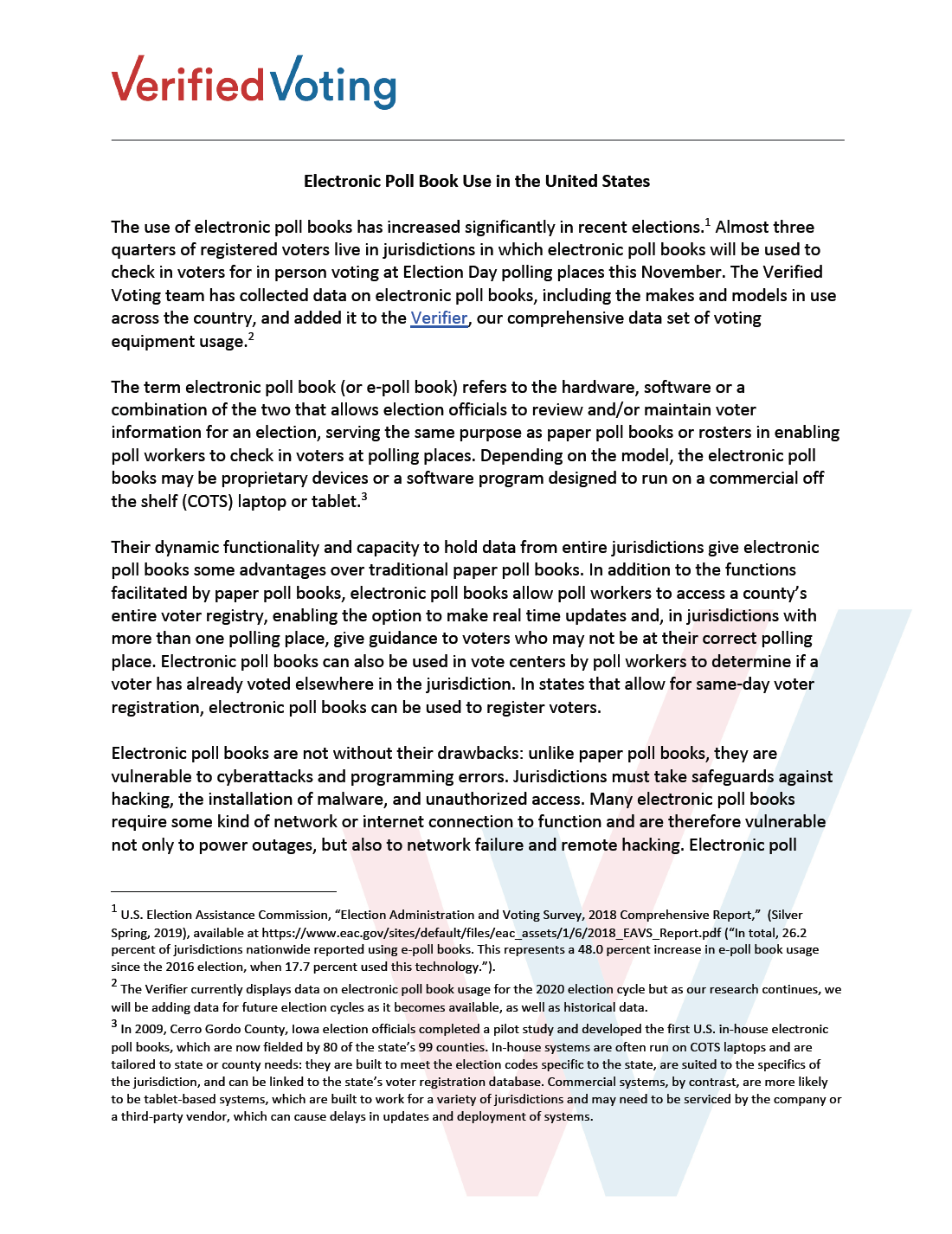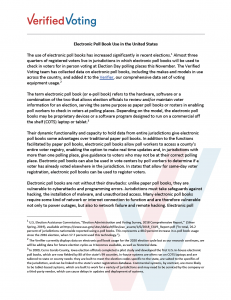
Resource
Electronic Poll Book Use in the United States
Date: August 31, 2020
Author: Verified Voting
Issue: Voting Equipment
Electronic Poll Book Use in the United States
The use of electronic poll books has increased significantly in recent elections.1 Almost three quarters of registered voters live in jurisdictions in which electronic poll books will be used to check in voters for in person voting at Election Day polling places this November. The Verified Voting team has collected data on electronic poll books, including the makes and models in use across the country, and added it to the Verifier, our comprehensive data set of voting equipment usage.2
The term electronic poll book (or e-poll book) refers to the hardware, software or a combination of the two that allows election officials to review and/or maintain voter information for an election, serving the same purpose as paper poll books or rosters in enabling poll workers to check in voters at polling places. Depending on the model, the electronic poll books may be proprietary devices or a software program designed to run on a commercial off the shelf (COTS) laptop or tablet.3
Their dynamic functionality and capacity to hold data from entire jurisdictions give electronic poll books some advantages over traditional paper poll books. In addition to the functions facilitated by paper poll books, electronic poll books allow poll workers to access a county’s entire voter registry, enabling the option to make real time updates and, in jurisdictions with more than one polling place, give guidance to voters who may not be at their correct polling place. Electronic poll books can also be used in vote centers by poll workers to determine if a voter has already voted elsewhere in the jurisdiction. In states that allow for same-day voter registration, electronic poll books can be used to register voters.
Electronic poll books are not without their drawbacks: unlike paper poll books, they are vulnerable to cyberattacks and programming errors. Jurisdictions must take safeguards against hacking, the installation of malware, and unauthorized access. Many electronic poll books require some kind of network or internet connection to function and are therefore vulnerable not only to power outages, but also to network failure and remote hacking. Electronic poll books require an upfront investment and must be programmed, tested, and serviced. They must also be carefully configured to reduce security risks;4 failure to do so properly could result in the wholesale malfunction of a countywide or statewide system. Poll workers also require proper training on using electronic poll books and backup plans to mitigate technology failures which have been shown to cause long lines and voter disenfranchisement.5
Of those registered voters who live in jurisdictions planning to use electronic poll books this November, more than 87.05% live in jurisdictions fielding commercial electronic poll books—systems that have been developed and sold by a non-governmental company—while the rest live in jurisdictions using “in-house” electronic poll books—systems built and programmed by the state or county election authorities.
Electronic Poll Books in Use
| States | Jurisdictions | % Jurisdictions | Precincts | % Precincts | Registered Voters | % Registered Voters | |
| Top Three
Most Common Commercial Systems |
49 | 1,117 | 17.53% | 77,936 | 43.76% | 89,293,856 | 42.09% |
| Other
Commercial Systems |
31 | 538 | 8.44% | 28,295 | 15.89% | 43,860,482 | 20.67% |
| In-House Systems | 8 | 394 | 6.18% | 12,319 | 6.92% | 19,802,771 | 9.33% |
| Totals | 39* | 2,049 | 32.15% | 118,550 | 66.57% | 152,957,109 | 72.10% |
Current as of 8/28/2020
* Some states use more than one system but are not counted twice for the total.
According to the National Conference of State Legislatures (NCSL), as of October 2019, 13 states certify electronic poll books, 12 states provide statewide procedures for electronic poll book usage but do not have a formal certification program, and 15 states have statutes authorizing the use of electronic poll books but have neither a certification process nor use procedures.6 Certification programs vary in their level of rigor and, according to a 2018 Brennan Center for Justice survey, of the 34 states that were using electronic poll books at the time, only half required paper backups to be present in every polling place at the time voting begins.7
Electronic poll books provide poll workers with varied functionalities that paper poll books do not. However, as with any computerized system used in elections, electronic poll books must function correctly and be resilient to failures or hacking attempts. Election officials must have election security practices embedded, including a robust backup plan to speedily check in voters if the technology fails. Verified Voting recommends paper copies of voter registration lists at all in-person polling locations as a recovery plan for technology failures so voters can still check in and vote efficiently on Election Day.

- U.S. Election Assistance Commission, “Election Administration and Voting Survey, 2018 Comprehensive Report,” (Silver Spring, 2019), available at https://www.eac.gov/sites/default/files/eac_assets/1/6/2018_EAVS_Report.pdf (“In total, 26.2 percent of jurisdictions nationwide reported using e-poll books. This represents a 48.0 percent increase in e-poll book usage since the 2016 election, when 17.7 percent used this technology.”). [↩]
- The Verifier currently displays data on electronic poll book usage for the 2020 election cycle but as our research continues, we will be adding data for future election cycles as it becomes available, as well as historical data. [↩]
-
In 2009, Cerro Gordo County, Iowa election officials completed a pilot study and developed the first U.S. in-house electronic poll books, which are now fielded by 80 of the state’s 99 counties. In-house systems are often run on COTS laptops and are tailored to state or county needs: they are built to meet the election codes specific to the state, are suited to the specifics of the jurisdiction, and can be linked to the state’s voter registration database. Commercial systems, by contrast, are more likely to be tablet-based systems, which are built to work for a variety of jurisdictions and may need to be serviced by the company or a third-party vendor, which can cause delays in updates and deployment of systems. [↩]
- Center for Internet Security, A Handbook for Elections Infrastructure Security, Version 1.0 (New York, 2018), 18–19, 33–34, https://www.cisecurity.org/wp-content/uploads/2018/02/CIS-Elections-eBook-15-Feb.pdf. [↩]
-
See e.g. Kim Zetter, “L.A. County has found the cause of its hours-long poll lines. It wasn’t the new voting machines,” Politico, June 17, 2020, https://www.politico.com/news/2020/06/17/la-county-blames-voter-check-in-tablets-for-election-day-chaos-324894; See also Andrea Córdova McCadney, “Want a Simple Way to Increase Election Security? Use Paper,” New York University Law School Brennan Center for Justice, Oct. 8, 2018, https://www.brennancenter.org/our-work/analysis-opinion/want-simple-way-increase-election-security-use-paper (suggesting that polling places using electronic poll books have both backup paper systems and enough provisional ballots to cover three hours of peak voting activity). [↩]
- National Conference of State Legislatures, “Electronic Poll Books | e-Poll Books,” October 25, 2019, https://www.ncsl.org/research/elections-and-campaigns/electronic-pollbooks.aspx. Currently, Maine is the only state that does not permit electronic poll books. [↩]
- Córdova McCadney, “Want a Simple Way to Increase Election Security? Use Paper.” [↩]